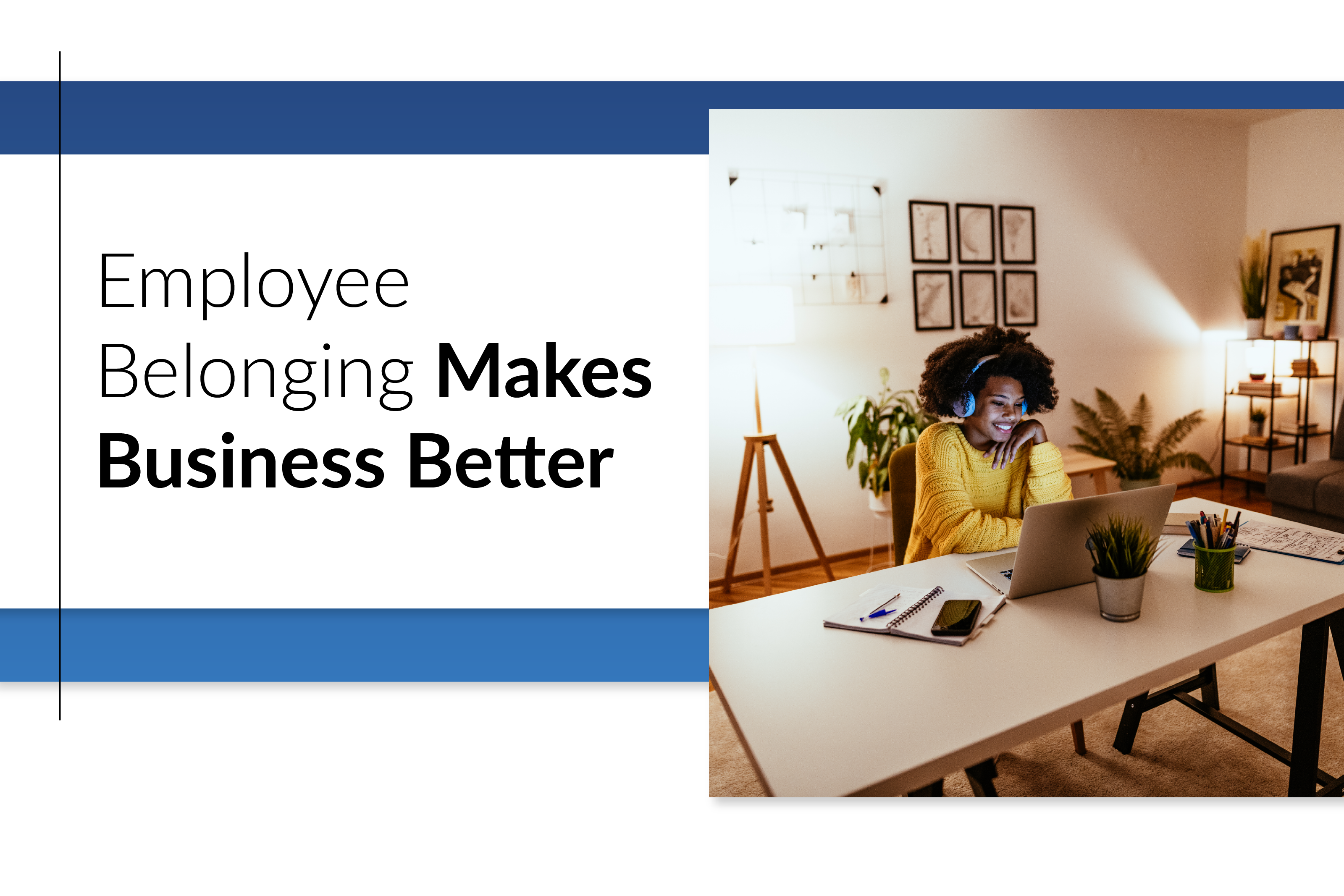It should come as no surprise that the spaces we occupy every day have a huge impact on our overall wellness. The Environmental Protection Agency and Vancouver Coastal Health report that Americans and Canadians spend about 90% of their time indoors. But what about the time we spend outdoors?
Your Welcoa membership has expired.
Employee Belonging Makes Business Better
The world of work has changed over the past few years. Many roles have shifted to hybrid or remote opportunities, allowing employees to have better flexibility with their schedules. And many are happier for it—they get more time back in their day to focus on their families, hobbies and other responsibilities outside of the workplace.
But lately, one in four employees—across companies, industries and demographics—feel like they don’t belong at work.[1] We wonder if the newly distributed workforce has anything to do with it. Without in-person interactions, it can be hard to make connections, build relationships on a personal level and truly know that you’re in an environment that welcomes you as you are.
Sadly, when people feel like they don’t belong, they stop bringing their whole selves to the workplace. Their creative ideas, suggestions and willingness to collaborate cease. Not only does this hurt the employee in terms of mental health and overall support, but it can also impact the organization.
A company-provided well-being program that focuses on bringing people together can make all the difference—for both employees and the employer. Below, we share the risks of ignoring the issue of not belonging at work, how designing an inclusive culture can improve business, and actionable ways to help employees find a sense of belonging in your workplace.
The Impact of Not Belonging at Work
People who don’t have good connections at work are:- Ten times lonelier than people who report having good relationships with their coworkers.
- Five times more likely to miss work due to stress.
- Two times more likely to miss work due to illness.
- Two times more likely to consider quitting their job.[2]
The people who don’t feel like they belong are lonely, stressed and sick. Their well-being is taking a hit in several areas. And we know that when one area is impacted, it also affects the others. For example, when someone’s mental health is suffering, they’re more likely to have poor sleep and eat less healthy and nutritious meals. This can create physical and clinical concerns, and over time, not giving your body what it needs can escalate mental health conditions even more. So when you don’t have an environment that makes people feel like they belong, you don’t just have a tired employee—you have an unhealthy and unhappy employee. And when they’re not at work, they still feel the impacts, which means it bleeds into all areas of their lives.
How should employers help? By creating opportunities for meaningful connections and enabling a culture where people feel they belong. But first, organizations must understand why it’s so important to help people feel like they belong there.
How Belonging Makes Business Better
It makes sense that feeling like you belong can lend itself to many benefits—better mood, higher psychological safety, more creativity and collaboration, the list goes on. In addition, people who feel like they belong will be empowered to speak up, take risks and be their true selves without worrying that they’d be punished or judged—which leads to better work performance. In one study, belonging was linked to a 56% increase in job performance, a 50% decrease in turnover risk, and a 75% reduction in sick days.[3]And part of feeling like you belong is by having meaningful connections with the people around you. Employees with strong social connections at work benefit from:
- Better relationships and collaboration between departments
- Stronger peer-to-peer support
- Feeling happier and more fulfilled at work
- Better productivity
- More engagement
- Improved retention[4]
Ways To Help People Feel a Sense of Belonging at Work
Organizational culture, leadership behavior and personal relationships are the factors that most influence an organization’s ability to create belonging.[5] Really, it all comes down to having a culture of well-being that backs up the promises you make as a company, and then making sure that leadership models the same behaviors you want your employees throughout the organization to have. To help your employees feel like they belong at your workplace, here are some benefits, policies and culture ideas to consider:Create a Culture of Well-Being
If you tell employees that you want them to focus on well-being and that your workplace is inclusive to the point that everyone feels like they belong, but your culture doesn’t match that, your words will fall flat. Worse even, your employees will simply stop trusting what you say.A culture of well-being can help you develop policies and procedures that act as the backdrop of everything you do—from how people lead the company to how employees and customers are treated. Once this culture is established, people will feel more comfortable opening up and bringing their whole selves into the workplace—allowing them to show up authentically and build stronger relationships with managers and colleagues that share similar struggles, interests, beliefs, and more. The avenues for belonging have now been opened!
Keep in mind that not everyone will want a workplace culture like yours, and that’s perfectly fine. However, once your culture is really defined and shines through in everything you do, you’ll start attracting and retaining employees who are looking for camaraderie in a place like yours.
Design a Holistic Well-Being Program That Factors in Belonging
Well-being programs are incredible tools for boosting morale, engagement and health. But they can also bring people together to discuss well-being interests, work on similar health goals, and share tips and tricks as each person works on their personal well-being journey.But you have to make sure that your well-being program is inclusive and includes options for everyone. For example, at WebMD Health Services, our platform and solutions offer many ways to keep people connected and feel a sense of belonging:
- Group Coaching by WebMD allows participants to learn from and discuss their goals with others who have similar interests,
- WebMD Health Coaches help people understand that there’s always someone in their corner. Individuals can connect one-on-one with an expert health coach in whatever way that’s convenient for them—online, over the phone, in-person, and more—to get personalized support, motivation and recommendations,
- Wellness challenges offer a little healthy competition between coworkers in a fun, engaging way that’s inclusive of all lifestyles and health goals, and
- Mental health support and mindfulness and meditation apps help people with whatever personal struggles they’re going through.
Offer Time Off To Volunteer for Organizations Your Employees Are Passionate About
People appreciate when their workplaces allow them to focus on other things they’re passionate about. One easy way to help people feel like they belong—while also making a difference—is to allow extra time off to volunteer for causes they care about. If the organizations match your company’s values and culture, consider getting the whole company involved, and match donations if possible.For example, we got behind one of our new employees when we found out he was an ambassador for an organization called Carry The Load. Within a month, WebMD sponsored a Carry The Load event, the sales team traveled to Dallas to march with him, WebMD employees got involved in local rallies, and the company raised over $4,300 for the cause. It’s now become a recurring thing we do here. Talk about feeling like you belong—especially when you’re a new employee!
Identify Intentional, Creative Ways To Bring People Together
Dispersed workforces, and even different schedules, can make connecting with coworkers difficult. But we know that social connections can help improve morale, collaboration and productivity. That’s why it’s up to organizations to design intentional ways to bring people together during the workday.These could be as simple as creating virtual calendar invites for things like watercooler chats, BINGO or trivia games. You can also plan in-person events for the whole company, single departments, or even local meet-ups for employees from the same region. There are even great plug-ins and platforms that connect colleagues together for serendipitous conversations, enabling people to connect with other employees they may not have otherwise gotten the chance to know.
Empower People To Create ERGs About Topics They Care About
It’s no secret that feeling like you belong includes social support. Having a group where people can share what they’re going through, learn from others in similar situations, and potentially create solutions to barriers in the workplace can have a tremendous positive impact on people’s moods and perceived feelings of belonging.If you don’t already have Employee Resource Groups (ERGs), now is a great time to include them as part of your culture. That’s because networks like these can help people find others within the organization that have similar interests and backgrounds, allowing them to build relationships with people they may not have otherwise been able to meet or collaborate with. And this, in turn, creates—you guessed it—a sense of belonging and understanding. You can start by suggesting a few groups that you know might be popular, such as Women At Work or a Mental Health Advocacy Group.
The trick here? Empower people to start and lead these groups with the knowledge that they’ll have executive buy-in, but leadership should mostly stay out of it. You don’t want employees thinking that you’re running the show or using ERGs as a way to inflate company goals. Instead, ERGs can be used as a resource for leadership to understand any challenges, issues, policies, and benefits that they can implement to better support the groups their employees are creating and advocating for.
Offer Flexible Schedules
Doesn’t it seem like lately, people have a lot going on? People want—and need—time during the day to take care of other responsibilities. Consider this: if a leader respects an employee enough to let them create a flexible work arrangement that fits their needs, they’ll be more appreciative and productive when they’re able to dedicate time to work. It’s a win-win. And ultimately, creating an environment where employees are empowered to act like the responsible adults that they are can inherently make them feel like they’ve found an organization where they belong—and they’ll be better workers because of it.Encourage Opinions, Ideas and Creative Input at Every Level
Sometimes, the quiet people in meetings have the best ideas. Unfortunately, they don’t always feel comfortable speaking up in group settings. Make sure managers find ways to empower everyone on their team to offer suggestions and input in ways that are most comfortable for them. For example, after a big group call, send an email to a quiet team member asking if they have any ideas they want to share. This can help people still feel like they’re part of a team and encourages them to continue contributing over the long run.Overall, feeling like you belong at work is a critical component to having happy, healthy employees and a great workplace environment. If you put in the effort to make sure people feel a sense of belonging in your organization, you’ll be amazed by the positive results you’ll see.
[1] BetterUp. 1 out of 4 of your employees feel they don’t fit in. Here’s why that matters, and what to do about it. May 3, 2021.
[2] Cigna. Loneliness and the Workplace. 2020.
[3] Harvard Business Review. The Value of Belonging at Work. December 16, 2019.
[4] Forbes. 5 Reasons Social Connections Can Enhance Your Employee Wellness Program. January 31, 2018.
[5] Deloitte. Belonging: From comfort to connection to contribution. May 15, 2020.

Christine Muldoon
Christine Muldoon is the Senior Vice President of Marketing and Strategy at WebMD Health Services. She is responsible for the company’s overall strategy and execution, including marketing, B2B and B2C communications, and market positioning. Additionally, Christine works extensively with clients and internal stakeholders to evaluate the market, leverage the voice of the customer, evaluate partnership opportunities, and operationalize opportunities for the company’s success. She has more than 20 years of experience in the healthcare industry.

WebMD Health Services
WebMD Health Services, part of the WebMD family, designs well-being programs for employers and health plans. These well-being programs empower populations to live healthier, happier lifestyles—all while helping the organizations exceed their business objectives. For more information, visit webmdhealthservices.com or contact us at connect@webmd.net.
WebMD Health Services was a 2022 WELCOA Summit Sponsor and are a proud partner of the WELCOA Premier Provider Network. To learn more visit their Vendor Profile.




